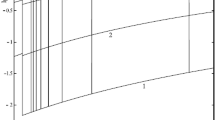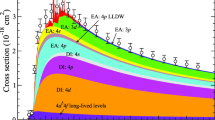Abstract
The nonempirical SCF method in the approximation of equivalent cores has been used to demonstrate the possibility of the dissociation process AFn + → AFn−1 ++F(1s12s22p6) for the ions CF4 +, PF5 +, and SF6 +, formed by Fls ionization of the uncharged molecules. It is concluded that the interpretation of the gas-phase FKα spectra based on the assignment of bands to transitions from the molecular levels of stationary states may not be applicable to these fluorides. Suggestions are made concerning the dissociation of the ions WF6 + and MoF6 + on Fls ionization.
Similar content being viewed by others
Literature cited
V. I. Vovna, A. V. Okotrub, A. V. Kondratenko, et al., “Electronic structures of the molecules of the hexafluorides of d-elements according to x-ray 684-03 spectra, photoelectron spectroscopy, and quantum-chemical calculations,• Papers presented to the 9th All-Union Conference on Physical and Mathematical Methods in Coordination Chemistry, Institute for Catalysis of the Siberian Section of the USSR Academy of Sciences, Vol. 2, Novosibirsk (1987), p. 81.
J. Muller and H. Agren, “Role of core hole state geometry in molecular electron spectroscopy,• Proceedings of the NATO Advanced Study Institute Conference on Molecular Ions: Geometrical and Electronic Structure, Isle of Kos, Sept. 30–Oct. 10 (1980), Interscience, New York and London, 1983, pp. 221–270.
V. B. Berestetskii, E. M. Lifshits, and L. P. Pitaevskii, Relativistic Quantum Theory [in Russian], Vol. 1, Izd. Nauka, Moscow (1968).
V. I. Nefedov and V. I. Vovna, The Electronic Structure of Chemical Compounds [in Russian], Izd. Nauka, Moscow (1987).
V. I. Nefedov, X-ray-electron Spectroscopy of Chemical Compounds [in Russian], Izd. Khimiya, Moscow (1984).
L. N. Mazalov, V. V. Murakhtanov, and A. V. Kondratenko, High-Energy Spectra of Molecules [in Russian], University of Novosibirsk (1984).
G. G. Furin, A. V. Zibarev, L. N. Mazalov, and V. D. Yumatov, The Electronic Structure of Organic Fluorine Compounds [in Russian], Izd. Nauka, Moscow (1988).
J. Muller, E. Poulain, and O. Goscinski, “Role of symmetry restrictions on valence binding energies of CF4,” J. Chem. Phys., 72, No. 4, 2587–2590 (1980).
Colin J. Marsden, “The harmonic force field for PF5 from ab initio calculations and experimental data. Comparison with SiF4, PF3, and SF6,” J. Chem. Phys., 87, No. 11, 6626–6634 (1987).
Author information
Authors and Affiliations
Additional information
Translated from Teoreticheskie i Éksperimental'naya Khimiya, Vol. 26, No. 6, pp. 729–732, November–December, 1990.
The authors thank A. I. Razgonov and N. V. Dobrodev for taking part in discussion of the results and in calculations of the line strengths of the FKα transitions by the Xα-SW method.
Rights and permissions
About this article
Cite this article
Falaleev, A.G., Andreev, V.A. & Vovna, V.I. The possible dissociation of the ions of some higher fluorides on X-ray Fls ionization. Theor Exp Chem 26, 682–685 (1991). https://doi.org/10.1007/BF00536438
Received:
Issue Date:
DOI: https://doi.org/10.1007/BF00536438




